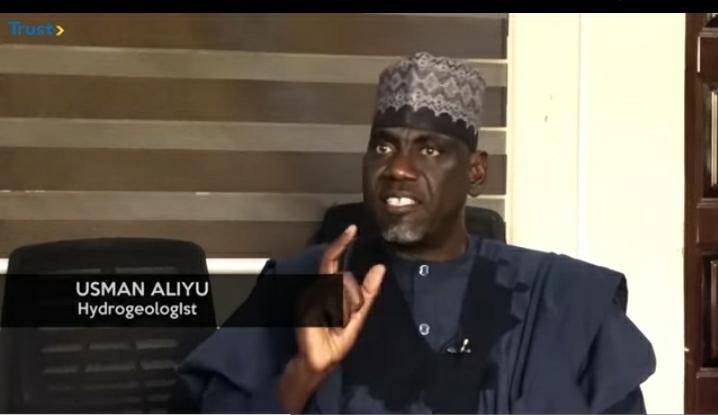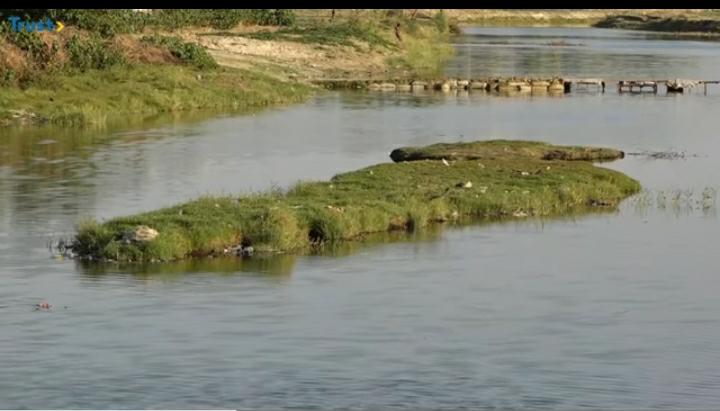*Pix above: Lake Chad, A shadow of its former self
PLEASE SHARE
Lake Chad, once a sprawling body of water spanning thousands of square kilometers, has become a shadow of its former self. The documentary “The Shrinking Lake Chad: Humanitarian and Environmental Impacts,” produced by Hauwa Kumshe of TrustTv, delves into the harrowing tale of this environmental catastrophe and its profound implications for millions of people who depend on its waters for their survival.

*Dr. Usman Aliyu
At the heart of the documentary is Dr. Usman Aliyu PhD (in view), a Hydrologist, environmental activist, seasoned humanitarian, social justice advocate, and known philanthropist. With his expertise and deep commitment to addressing the challenges facing Lake Chad, Dr. Usman serves as a focal point for understanding the multifaceted issues plaguing the region.
For generations, Lake Chad has been a lifeline for millions of people across Nigeria, Cameroon, Niger, and Chad. Its waters have sustained thriving fishing communities, provided water for irrigation, and supported diverse ecosystems. However, relentless environmental degradation, exacerbated by climate change, has pushed this vital resource to the brink of collapse.
Dr. Usman highlights the critical role that Lake Chad plays in the socio-economic fabric of the region. As he points out, the lake is not just a source of food and water but also a cultural heritage that binds communities together. However, the alarming rate of its shrinkage, with its surface area reduced by over 90% between 1965 and 1985, paints a bleak picture for the future.
Climate change, over-extraction of water, and upstream dam constructions are identified as key drivers of the lake’s decline. Dr. Usman emphasizes that these factors have triggered a chain reaction of ecological and socio-economic consequences, exacerbating existing challenges such as land degradation, loss of arable land, and increased competition for dwindling resources.
The shrinking of Lake Chad has far-reaching implications, extending beyond environmental concerns to security threats and humanitarian crises. As insurgency and conflict ravage the region, communities dependent on the lake for their livelihoods face displacement, food insecurity, and economic hardship.
Amidst these challenges, Dr. Usman emphasizes the urgent need for concerted action to mitigate the effects of climate change and preserve Lake Chad for future generations. He calls for public awareness campaigns, sensitization efforts, and dredging of the lake to restore its ecological balance.
Furthermore, Dr. Usman outlines the three main aspects of climate change—depletion of the ozone layer, global warming, and the greenhouse effect—and underscores the importance of addressing each through measures such as massive tree planting campaigns.
As the documentary draws to a close, the message is clear: the fate of Lake Chad hangs in the balance. Without decisive action to address the underlying causes of its decline, millions of people face an uncertain future, deprived of their most precious resource.
Dr. Usman added also that disappearance of Lake Chad, once a thriving body of water, stands as a stark testament to the impact of human activity on the environment. At the heart of this crisis lies a complex interplay of factors, including the enlightenment era’s emphasis on industrialization and progress at any cost. As societies embraced technological advancements and pursued economic growth, they often did so at the expense of the natural world. The exploitation of natural resources, including water from Lake Chad, was driven by a desire for wealth and power, leading to unsustainable practices that contributed to the lake’s decline.
The disappearance of Lake Chad has also exacerbated existing crises among farmers and herders who rely on its waters for sustenance. As the lake has shrunk, competition for dwindling resources has intensified, leading to conflicts over access to water and grazing land. These conflicts, rooted in centuries-old disputes over land and resources, have been further fueled by environmental degradation and population growth. Farmers and herders, once able to coexist harmoniously, are now pitted against each other in a struggle for survival, exacerbating tensions and deepening social divisions along the shores of Lake Chad.
The scarcity of arable land for cultivation along the shores of Lake Chad has also been compounded by the region’s antiquated land tenure system. As the lake has receded, fertile land suitable for agriculture has become increasingly scarce, leading to disputes over land ownership and usage rights. In many cases, traditional land tenure systems have proved inadequate in addressing these challenges, leaving communities vulnerable to exploitation and displacement. The need for sustainable land management practices and equitable land distribution has never been more urgent, as communities grapple with the profound impacts of environmental degradation and resource scarcity.
In confronting the disappearance of Lake Chad and its far-reaching consequences, it is essential to recognize the interconnectedness of human societies and the natural world. The crisis facing Lake Chad is not merely an environmental issue but a reflection of broader societal trends and systems of governance. By acknowledging the role of human nature in driving environmental degradation and social conflict, we can begin to address the root causes of the crisis and work towards sustainable solutions that promote harmony between people and the planet.
The Boko Haram insurgency has had devastating consequences for the environment along the shores of Lake Chad. Anthropogenic activities, including deforestation for self-defense purposes, have led to the depletion of trees in the region. Both Boko Haram militants and the military have engaged in cutting down trees to improve visibility and detect potential attacks from a distance, further exacerbating the environmental degradation in the area. Additionally, the emergence of Boko Haram has disrupted traditional livelihoods, forcing some people to turn to cutting down trees for charcoal production as a means of survival. This has further contributed to deforestation and desertification along the shores of Lake Chad, exacerbating the already dire environmental challenges facing the region.
A call for an urgent action is needed to mitigate climate change and desertification along the shores of the lake to secure food security and sustainable livelihoods before it is too late. Dr. Usman Aliyu’s recommendations for public awareness campaigns, sensitization on climate change, massive tree planting, smart agriculture practices, and the employment of agriculture extension officers are crucial steps towards building climate change adaptation and resilience in the region.
Sheriff Wali of the Lake Chad Research Institute underscores the challenges posed by insecurity, which hampers efforts to study and mitigate the lake’s decline. The insurgency has forced researchers to seek refuge in neighboring states, further impeding scientific interventions to address the crisis.
Usman Aisami of the Ministry of Animal Research and Fisheries laments the dwindling number of fishermen, reflecting the devastating impact of the lake’s deterioration on livelihoods and economic activities.
In conclusion, “The Shrinking Lake Chad: Humanitarian and Environmental Impacts” serves as a poignant reminder of the urgent need to prioritize environmental conservation and sustainable development in the face of mounting challenges. Some insights were made as a guiding beacon, the documentary sheds light on the plight of Lake Chad and calls for collective action to safeguard this vital resource for generations to come./PLEASE SHARE
✍️✍️Mohammad Tijjani Bukar
5th April, 2024. Lakechad: the Economic Fabric Of The Region.





